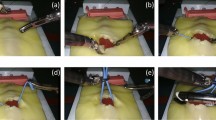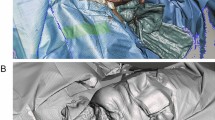Abstract
For the inexperienced individual, learning surgical techniques can be taxing. The authors developed a rodent surgery dry lab training program to assist educational and research institutions in providing low-stress training for basic surgical techniques using handmade, cost-effective simulation models. The program not only helps students develop essential skills in basic surgery, but also fulfills the mandate of the 3Rs by allowing students to repeatedly practice and refine their skills on models rather than live animals. This type of training is a valuable tool in bridging the gap between computer training and training with live animals.
This is a preview of subscription content, access via your institution
Access options
Subscribe to this journal
We are sorry, but there is no personal subscription option available for your country.
Buy this article
- Purchase on Springer Link
- Instant access to full article PDF
Prices may be subject to local taxes which are calculated during checkout




Similar content being viewed by others
References
Russell, W.M.S. & Burch, R.L. The 3R's. The IACUC Handbook, 2nd edn. (CRC Press, Boca Raton, FL, 2007).
Public Health Service. Policy on Humane Care and Use of Laboratory Animals (US Department of Health and Human Services, Washington, DC, 1986; reprinted 2002).
Institute for Laboratory Animal Research, National Research Council. Guide for the Care and Use of Laboratory Animals (National Academy Press, Washington, DC, 1996).
Stevens, C.A. Guidelines for Rodent Survival Surgery. (Internal Central Michigan University IACUC approved guideline, 2006).
Department of Health and Human Services, Centers for Disease Control and Prevention & National Institutes of Health. Biosafety in Microbiological and Biomedical Laboratories, 5th edn. (US Government Printing Office, Washington, DC, 2007). http://www.cdc.gov/OD/OHS/biosafety/bmbl5/bmbl5toc.htm.
Stevens, C.A. Biohazardous Waste Management Plan. (Internal Central Michigan University approved guideline, 2004).
Brown, P.A. & Hoogstraten-Miller, S. Principals of Aseptic Rodent Survival Surgery: General Training in Rodent Surgery-Part 1. Retrieved August 2004 from International Veterinary Information Service. Website: http://www.ivis.org). (2004)
Acknowledgements
The authors thank Ingrid Parrington for her technical help and Susan Cook for her confidence and instruction, as well as Paul Snyder, Audrey Brown, Jeanni Gaymer, Daniele Ferguson and Brenda Paschke for their assistance as instructors.
Author information
Authors and Affiliations
Corresponding author
Ethics declarations
Competing interests
The authors declare no competing financial interests.
Rights and permissions
About this article
Cite this article
Stevens, C., Dey, N. A program for simulated rodent surgical training. Lab Anim 36, 25–31 (2007). https://doi.org/10.1038/laban1007-25
Received:
Accepted:
Issue Date:
DOI: https://doi.org/10.1038/laban1007-25



